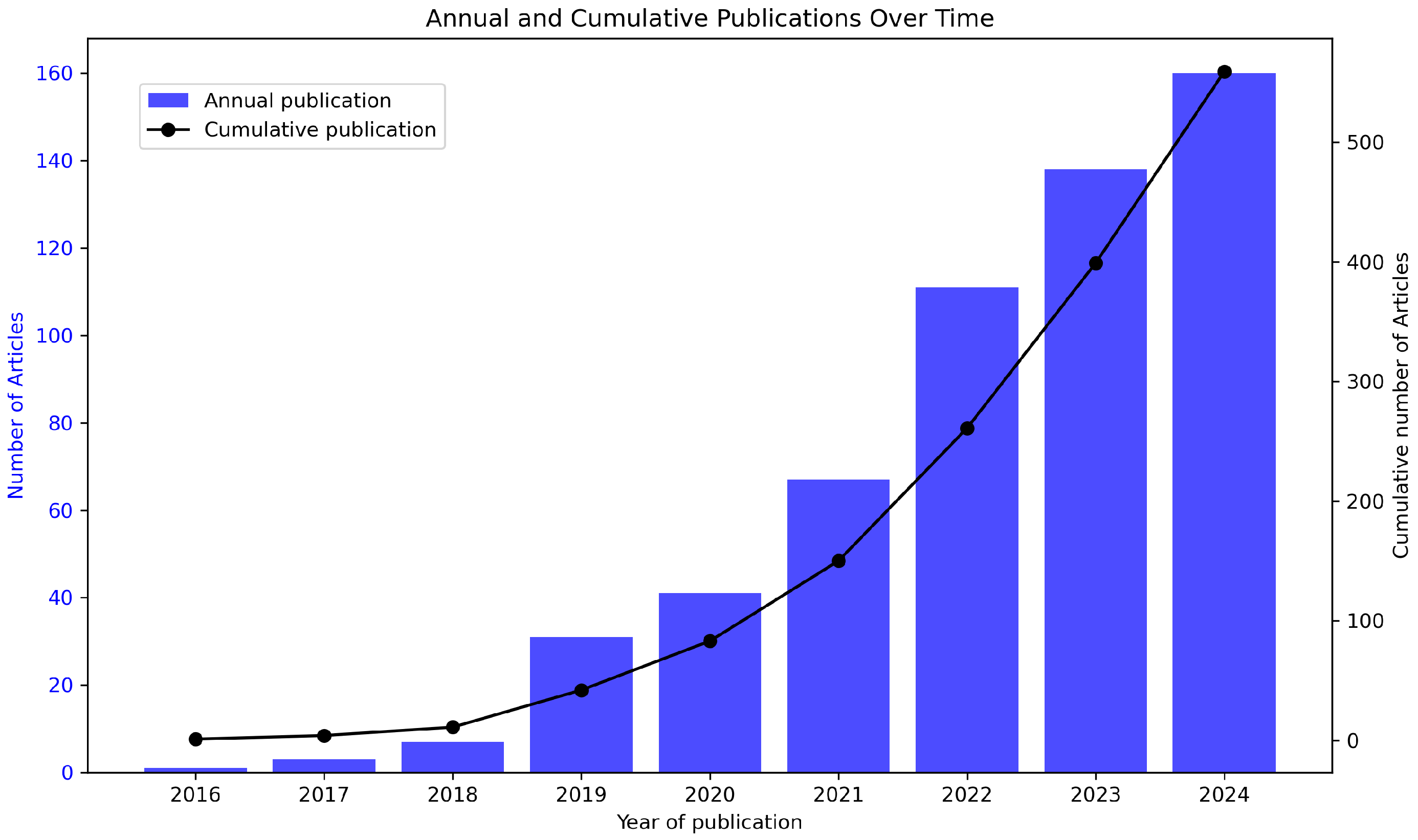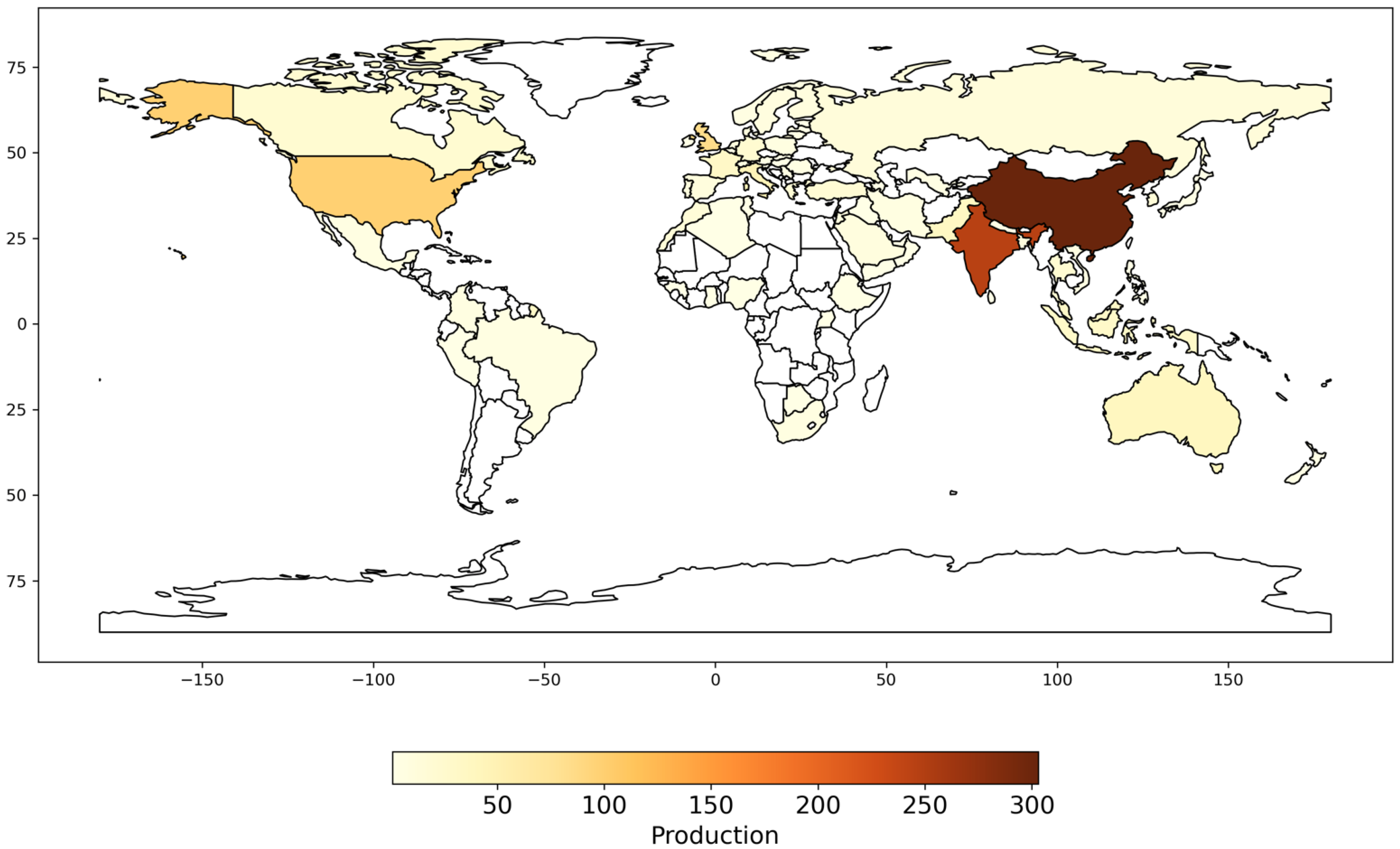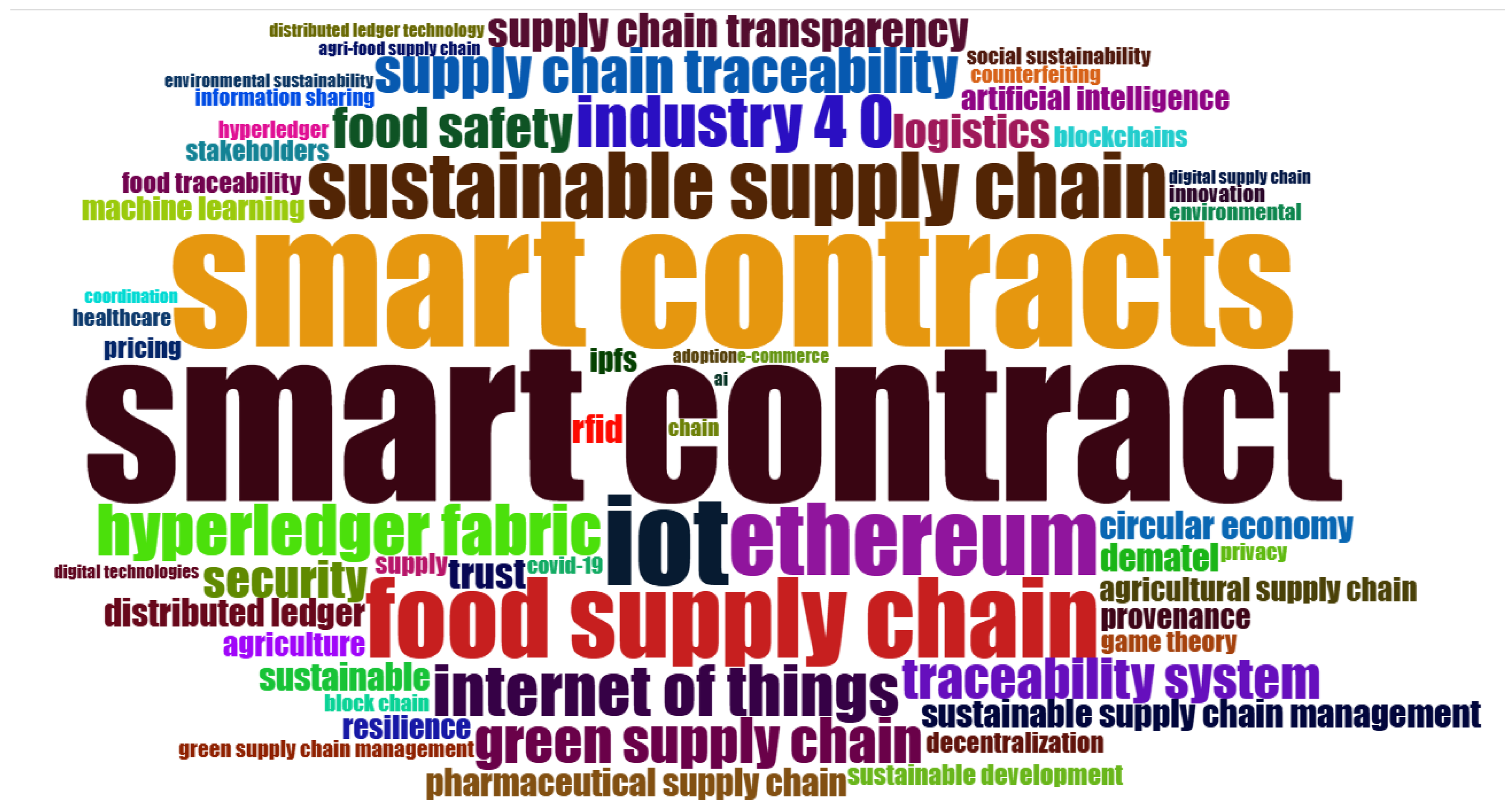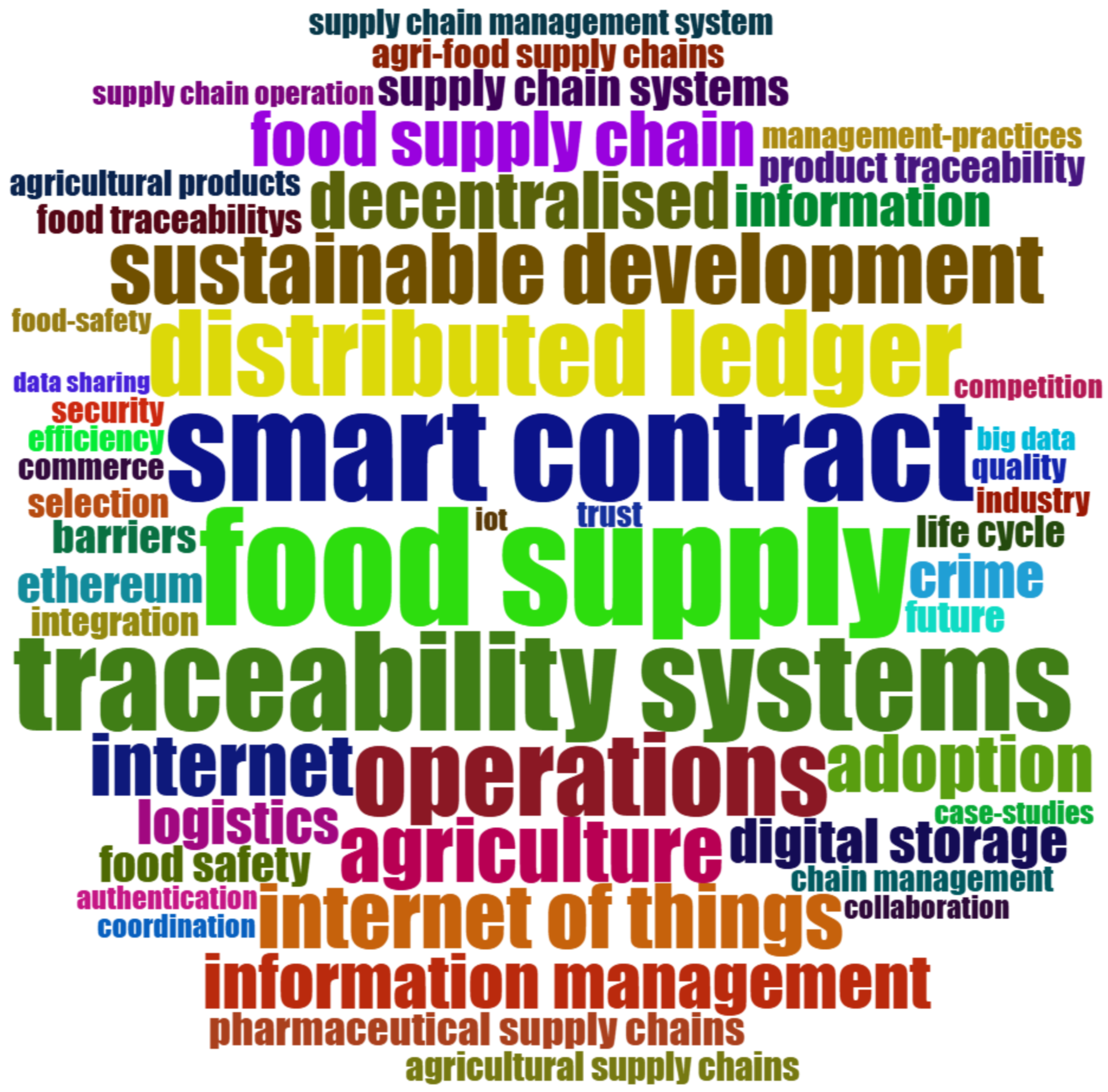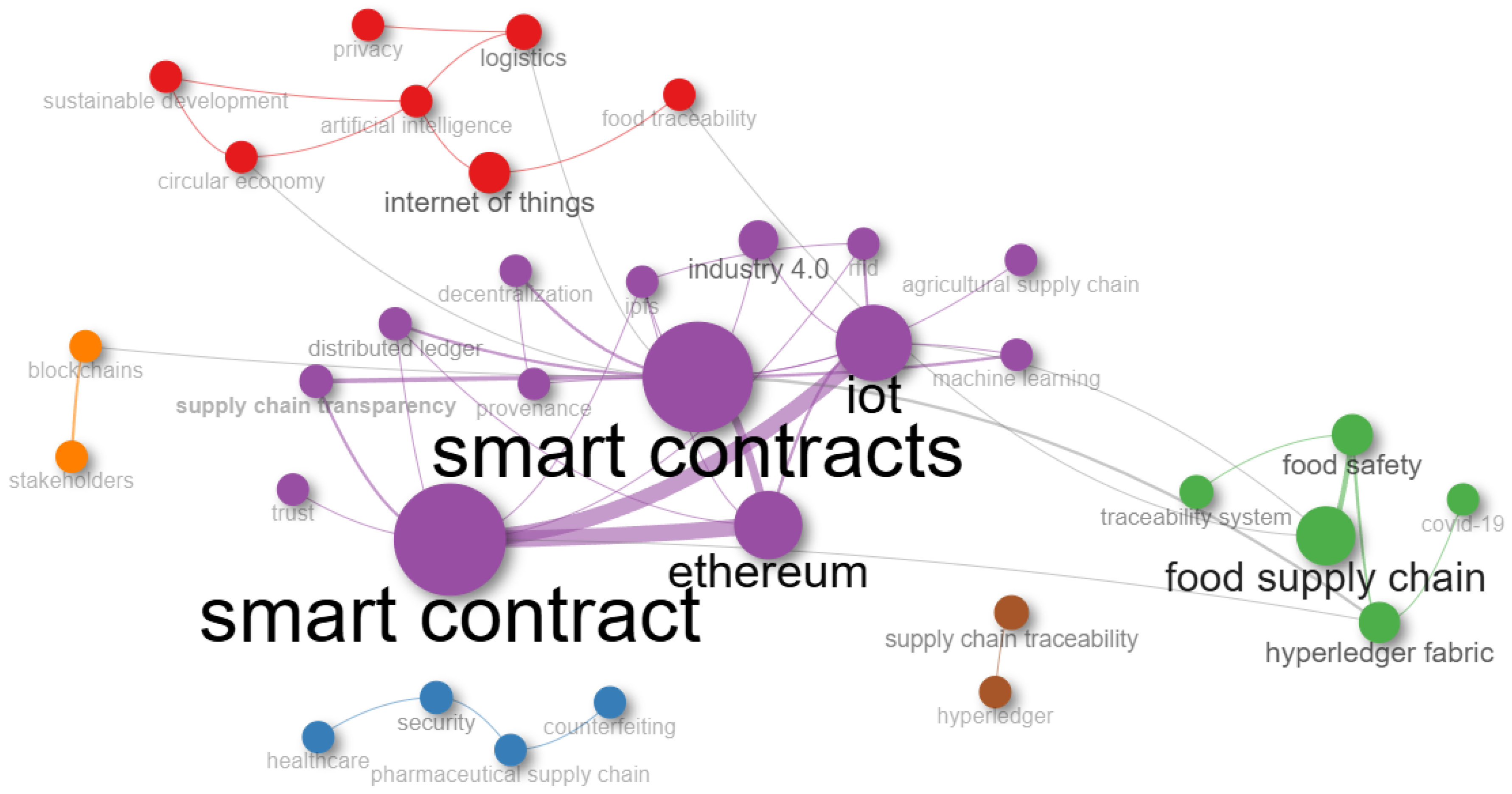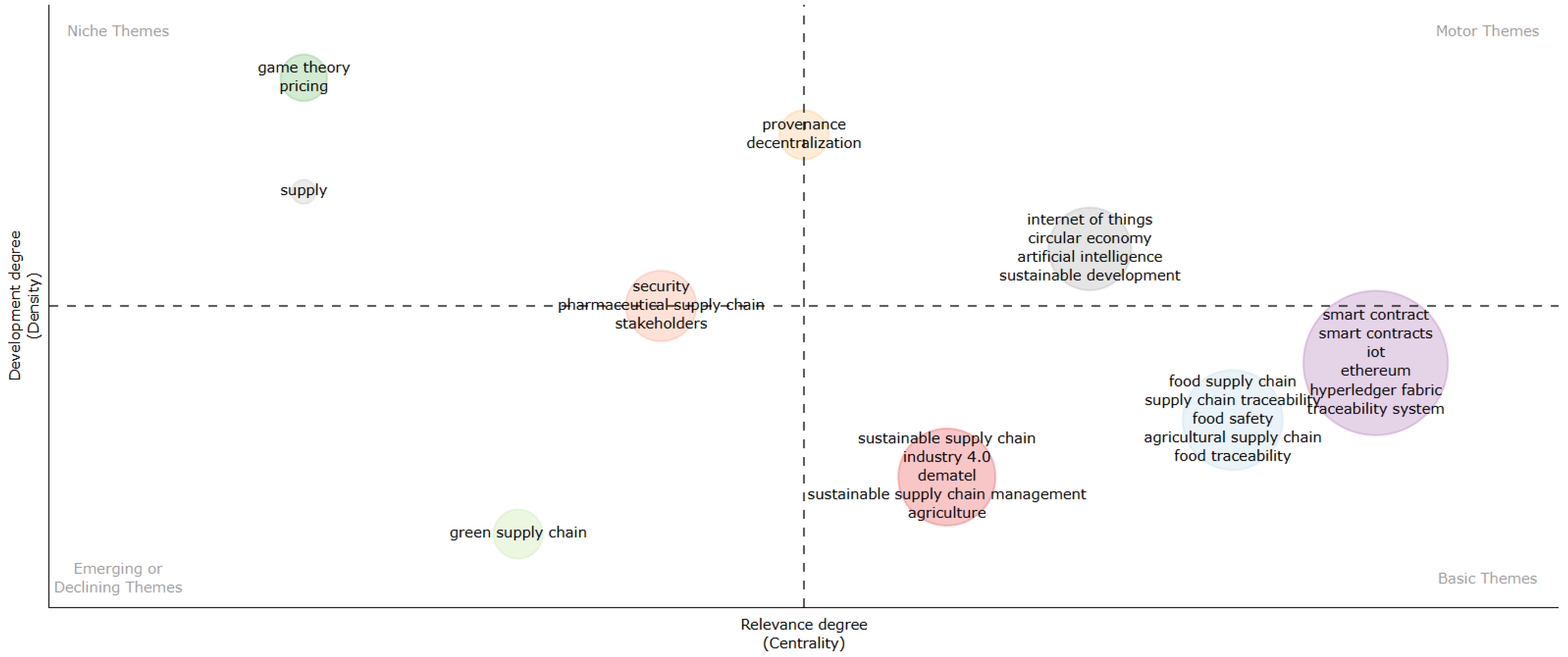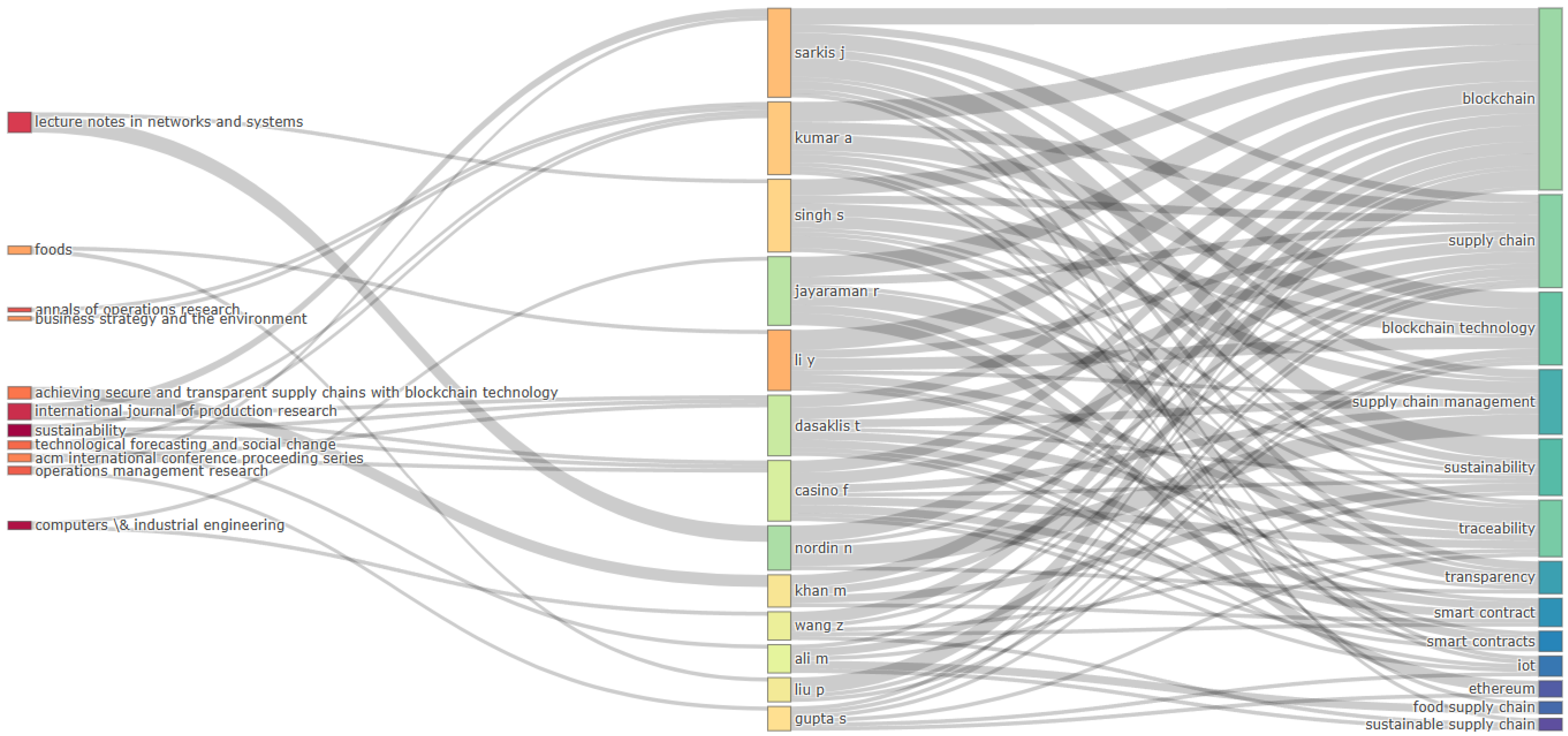3.2. Geographical and Institutional Analysis
The global distribution of scientific production reveals significant regional disparities in blockchain research applied to sustainable and transparent supply chains. As shown in
Figure 3, China (303 publications) and India (246 publications) dominate, jointly accounting for about 49.2% of the total output. The latter reflects strong national strategies supporting digital innovation, particularly in logistics, agriculture, and public administration.
Other major contributors include the United States (100), the United Kingdom (84), and Italy (47), reflecting sustained academic engagement in both technological development and the integration of sustainability. Additionally, countries such as Australia (38), Pakistan (36), France (32), Malaysia (32), and Indonesia (30) underscore growing interest beyond the traditional Global North. Several countries present identical levels of productivity, highlighting an interesting parity between different geographic and economic contexts. For instance, Germany and Canada both contributed 22 publications, while Bangladesh, Finland, Jordan, Portugal, and Saudi Arabia each produced 10, indicating the involvement of both developed and emerging economies.
In Latin America, participation remains limited. Colombia leads the region with eight publications, followed by Brazil and Mexico (six each), and Peru with a single contribution. In Africa, research output is similarly concentrated, with Morocco (16) and South Africa (7) as the most active countries. Other nations such as Botswana, Ethiopia, Ghana, Nigeria, and Uganda contributed fewer than four publications each. Notably, over 60 countries produced between one and nine publications, reflecting a globally dispersed but still peripheral engagement. The aforementioned countries include those from Eastern Europe (e.g., Slovakia, Slovenia), the Middle East (e.g., Oman, Yemen), and sub-Saharan Africa (e.g., Guinea, Ethiopia, Uganda). Although their contributions were modest, their presence signals a broader diffusion of academic interest in blockchain-based supply chain research, even in regions traditionally underrepresented in global scholarship.
At the institutional level, as illustrated in
Table 1, Northeastern University (United States) leads with 11 publications, followed by Beijing Technology and Business University, Henan Agricultural University, and the University of Electronic Science and Technology of China, each with 8 publications. Other significant contributors include Auburn University (United States), Chulalongkorn University (Thailand), Guangzhou University (China), Harbin University of Commerce (China), Henan University of Technology (China), the Hong Kong Polytechnic University (Hong Kong), and the University of British Columbia (Canada), each with seven publications. While these institutions represent a geographically diverse research landscape, the concentration of leading institutions in China is consistent with the prominent position of the country in blockchain-related supply chain research.
Institutions with six publications—such as Aalborg University (Denmark), Hunan University (China), the Indian Institute of Management (India), IPB University (Indonesia), Khalifa University (United Arab Emirates), Providence University (Taiwan), the School of Computer Science and Engineering (Singapore), the University of Nottingham (United Kingdom), and Yaşar University (Turkey)—further reflect the global distribution of academic engagement. This group highlights the emergence of new research hubs that are developing sustainable supply chains enabled by blockchain technology.
Table 2 provides a detailed overview of the corresponding author countries involved in blockchain-related supply chain research. This metric identifies the origin of academic leadership in each publication, highlighting institutional authority and national engagement in advancing scholarly efforts. China (18.2%) and India (15.4%) dominate publication volume among the leading countries. However, both exhibit a strong predominance of single-country publications (SCPs)—70.6% and 77.9%, respectively—indicating that most research leadership is domestically concentrated. The latter reflects robust national research systems but limited integration into international academic networks. In contrast, the United Kingdom demonstrates a more balanced profile, with 53.8% SCPs and 46.2% multiple-country publications (MCPs), indicating strong involvement in global academic collaborations. Similarly, France (50.0% SCPs, 50.0% MCPs) and Pakistan (44.4% SCPs, 55.6% MCPs) illustrate cases where corresponding authors actively engage in national and international research contexts, despite a lower overall output. Some countries display a clear inclination toward domestic research leadership. Despite having well-developed research infrastructures, Italy (94.7% SCPs) and Australia (88.9% SCPs) report limited MCPs, suggesting a more nationally focused research strategy. Likewise, Colombia, Greece, and Portugal each report 100% SCPs, highlighting a lack of international collaboration among their corresponding authors. Meanwhile, emerging research hubs such as South Africa and the United Arab Emirates present an encouraging pattern: both record 50.0% MCPs, even though they each contribute only 0.7% of total publications. This trend indicates a growing effort to integrate into international research dialogues. Notably, while accounting for 4.1% of publications, the United States shows a high SCP ratio (87.0%), implying that even global leaders in research output may pursue predominantly domestic approaches. In comparison, Canada (33.3% MCPs), Germany (40.0% MCPs), and the Netherlands (20.0% MCPs) contribute modestly in volume yet reflect varying degrees of international engagement. This analysis reveals three general patterns:
High-output, low-collaboration countries (e.g., China, India, the USA).
Countries with balanced international collaboration (e.g., the UK, France, Pakistan).
Emerging or regionally focused contributors with high SCP rates (e.g., Portugal, Colombia) or promising MCP shares (e.g., UAE, South Africa).
This institutional analysis underscores the importance of fostering global collaboration and integrating a broader range of countries into blockchain research for sustainable supply chains. The observed patterns highlight strategic opportunities for capacity building and policy development, particularly in countries with strong domestic leadership but limited international cooperation. Enhancing global networking and participation in cross-border research consortia could increase the impact and inclusiveness of scholarly work in this field. The following section explores the influence of key authors and co-authorship networks in shaping these collaborative dynamics.
The predominance of China and India in scientific output can be partly attributed to their national strategies, which actively promote digital innovation and the integration of blockchain technologies, particularly in sectors such as logistics, agriculture, and public administration. However, despite their high publication volume, both countries demonstrate a notable prevalence of SCPs, suggesting limited participation in cross-border research collaborations. This pattern may be shaped by various structural and contextual factors, including language barriers, policy-driven research priorities, and a tendency to favor publication in domestically affiliated journals that are nonetheless indexed in international databases. Understanding these underlying drivers is essential for contextualizing the observed global asymmetries in blockchain research. Moreover, it underscores the importance of fostering more inclusive and collaborative international research networks that can bridge geographic, linguistic, and institutional divides.
3.3. Authors and Collaboration Networks
Table 3 presents the most relevant authors regarding publication productivity and fractionalized contribution within the domain of blockchain applications in sustainable supply chains. Li Y. leads with 10 articles; however, a fractionalized score of 2.25 suggests that most of these publications were produced in highly collaborative environments, where individual contribution is distributed among several co-authors. Similarly, Sarkis J., with nine articles and a fractionalized count of 2.78, reflects strong research engagement, yet also within multi-authored studies.
In contrast, Liu P. stands out for having both a moderate number of articles (six) and the highest fractionalized value (3.12), indicating a more central authorship role and potentially more significant individual influence in the field. Sunmola F. (five articles, 2.67 fractionalized) and Khan M. (six articles, 2.58 fractionalized) follow similar patterns, combining relatively fewer papers with significant fractional authorship, which may denote primary or lead author positions in smaller research teams.
Authors such as Singh S. (seven articles, 2.38 fractionalized) and Gupta S. (six articles, 1.07 fractionalized) demonstrate contrasting contributions: the former suggests active involvement across a moderate number of studies with a notable share of authorship, whereas the latter may have played a more peripheral role despite similar output volume.
Overall,
Table 3 highlights the importance of using both absolute and fractionalized publication counts when assessing academic productivity. While article count captures publication frequency, the fractionalized metric offers insight into the depth of individual involvement, which is particularly valuable in fields characterized by collaborative research practices.
In terms of collaboration networks,
Figure 4 reveals distinct research clusters. Sarkis J. maintains an extensive network by collaborating with multiple authors in diverse research initiatives. Similarly, Kumar A. and Singh S. form a well-connected cluster focused on sustainability and blockchain applications. Additionally, Casino F. and Dasaklis T. exhibit strong co-authorship ties, particularly in blockchain-based risk management strategies for supply chains. Conversely, a more fragmented collaboration pattern is observed for Li Y., who, despite leading in publication count, operates within a smaller, more specialized network. Authors such as Salah K. and Jayaraman R. demonstrate strong dyadic partnerships, emphasizing focused contributions to specific blockchain applications. The bibliometric network also highlights authors working within isolated clusters, such as Ali M. and Sunmola F., whose contributions appear independent rather than integrated into broader research collaborations. Similarly, Gupta S. and Wang Z. maintain limited but well-defined connections, suggesting more specialized research efforts rather than widespread international engagement.
Additionally, Khan M. and Khan S. demonstrate a closely linked research effort, forming a smaller yet concentrated collaboration. Their partnership, along with contributions from Liu P. and Liu Y., reflects domain-specific studies that may not yet be fully integrated into larger research networks.
A notable aspect of the network structure is the presence of smaller, specialized research groups, such as the one formed by Sunmola F. and Burgess P., which operates independently of major co-authorship clusters. This separation may indicate a focus on niche research topics or a lack of broader interdisciplinary collaboration. Authors with higher publication counts, such as Li Y. and Sarkis J., tend to lead or be embedded in larger research clusters, reinforcing their role in shaping the field. In contrast, mid-tier contributors like Kumar S. and Liu J. remain within collaborative networks but often work in smaller teams or as co-authors in larger projects.
The varied collaboration structures reveal both well-integrated networks and isolated contributors. While leading authors establish broad collaborations, smaller independent clusters suggest opportunities for greater international cooperation. This diversity in research networks points to the emergence of distinct thematic areas, which can be further explored by analyzing keywords and research topics.
3.4. Analysis of Keywords and Emerging Topics
The analysis of Author Keywords and Keyword Plus provides insights into the dominant research themes and emerging trends in blockchain applications for supply chains.
Figure 5 and
Figure 6 illustrate the most frequently occurring keywords, highlighting key areas of academic interest.
Before analyzing the most frequent keywords, it is important to note that specific terms were removed from consideration due to their lack of analytical value. These include words that were part of the original search equation (e.g., “blockchain”, “supply chain”, “traceability”, “sustainability”, “supply chain management”, “transparency”), as well as generic terms that do not contribute to thematic differentiation (e.g., “management”, “technology”, “challenges”, “framework”, “impact”, “performance”, “model”, “system”, “sustainable supply chains”, “systems”, “design”, “supply chains”). Removing these terms ensures that the analysis focuses on specific research directions rather than redundantly reaffirming the search strategy.
Among the Author Keywords shown in
Figure 5, the predominance of “smart contract” (47 occurrences) and “smart contracts” (39 occurrences) underscores a central thematic focus on automation and transaction validation within blockchain-enabled supply chains. This trend aligns with the broader movement toward digitalization and decentralized governance models in supply chain management. Additionally, the frequent appearance of terms such as “IoT” (26 occurrences), “Internet of Things” (15), and “Ethereum” (21) reflects a significant intersection between blockchain and emerging digital technologies. These keywords suggest a strong emphasis on real-time data acquisition, connectivity, and traceability—capabilities that are foundational for enhancing operational visibility and responsiveness. Moreover, the presence of domain-specific terms such as “food supply chain” (23), “food safety” (12), and “agricultural supply chain” (7) underscores the growing relevance of blockchain in the agri-food sector. In this context, the technology is being leveraged to enhance transparency, ensure product provenance, and reinforce quality assurance mechanisms.
The appearance of “Hyperledger Fabric” (15) indicates sustained interest in permissioned blockchain frameworks, particularly those designed for enterprise-level implementations that require enhanced security, scalability, and access control. Sustainability-related keywords—including “sustainable supply chain” (19), “green supply chain” (13), “circular economy” (8), and “sustainable development” (6)—point to a growing, albeit fragmented, integration of environmental concerns within blockchain discourse. The latter suggests that while the alignment between blockchain and sustainability is gaining traction, it remains an emergent area of exploration. In parallel, governance- and compliance-oriented terms such as “trust” (9), “security” (11), and “supply chain transparency” (10) underscore the perceived role of blockchain in enhancing accountability and integrity across supply networks.
Furthermore, the presence of keywords such as “traceability system” (12), “pharmaceutical supply chain” (8), and “resilience” (7) indicates an increasing interest in applying blockchain to high-risk or tightly regulated sectors, where traceability and system robustness are crucial. Finally, the emergence of “machine learning” (7) and “artificial intelligence” (7) as Author Keywords reflects a nascent interdisciplinary convergence. These terms suggest potential synergies between blockchain and data-driven technologies, particularly in applications such as predictive analytics, quality control, and risk management within complex supply chain ecosystems.
The Keyword Plus analysis, as shown in
Figure 6, reinforces and broadens the thematic structure identified through the Author Keywords. Notably, the recurrence of “food supply” (45 occurrences) and “smart contract” (40) confirms the central importance of traceability, automation, and food system integrity in blockchain-based supply chains. Closely associated terms such as “traceability systems” (38), “distributed ledger” (33), and “operations” (32) further emphasize blockchain’s dual role as both a mechanism for ensuring data integrity and a tool for optimizing supply chain operations.
Additionally, the presence of sustainability-related terms—such as “sustainable development” (27), “agriculture” (25), “food safety” (14), and “life cycle” (12)—reflects a growing, albeit still nascent, incorporation of environmental and social goals within blockchain supply chain applications. These concepts align with the ESG-oriented themes discussed in the previous section and suggest the potential for deeper integration through operational frameworks, such as Life-Cycle Assessment (LCA). Moreover, the recurrence of keywords like “Internet of Things” (25), “Ethereum” (14), “digital storage” (17), and “information management” (21) highlights the technological ecosystem underpinning blockchain. These terms underscore the relevance of interoperability, decentralized data architectures, and the convergence of blockchain with Industry 4.0 technologies.
Emerging concerns are also evident, as indicated by terms such as “crime” (17), “authentication” (9), “trust” (10), and “barriers” (13), which reflect a growing awareness of challenges related to cybersecurity, regulatory compliance, and user adoption. Furthermore, the inclusion of keywords such as “pharmaceutical supply chains” (13) and “coordination” (9) suggests an expanding interest in applying blockchain to high-stakes sectors that demand rigorous transparency, coordination, and governance.
Taken together, the Keyword Plus terms not only complement the Author Keywords but also reveal broader thematic linkages and co-citation patterns within the literature. Hence, while blockchain’s potential for enhancing traceability and automation is well recognized, its systematic integration with sustainability principles and risk governance mechanisms remains a promising avenue for future empirical research.
The keyword co-occurrence network, as shown in
Figure 7, illustrates the interconnections among the most frequently used terms in the literature, revealing six distinct research clusters. Each cluster, represented by a unique color, corresponds to a specific thematic focus within the domain of blockchain-enabled supply chain research. The clustering of keywords in the co-occurrence network was performed using the Walktrap algorithm in Biblioshiny. This method detects communities based on short random walks and groups of highly interconnected terms. Such clustering enables the identification of thematically cohesive groups within the literature, facilitating the interpretation of emerging and consolidated research areas.
The violet cluster represents the technological foundation of the field. It encompasses keywords such as “smart contracts”, “Ethereum”, “IoT”, “Industry 4.0”, “agricultural supply chain”, “supply chain transparency”, “decentralization”, “machine learning”, “distributed ledger”, and “trust”. Collectively, these terms highlight the integration of blockchain with digital transformation tools to enhance automation, traceability, and transparency, particularly in agriculture and other data-intensive sectors.
The green cluster centers on food supply chain safety and traceability. It includes terms such as “food supply chain”, “food safety”, “Hyperledger Fabric”, “traceability system”, and “COVID-19”. This grouping highlights the role of blockchain in enabling end-to-end traceability, enhancing food safety protocols, and mitigating disruption risks, especially in agri-food systems affected by global health crises.
The red cluster emphasizes the intersection of logistics, sustainability, and digital innovation. It incorporates keywords like “Internet of Things”, “logistics”, “food traceability”, “privacy”, “circular economy”, “sustainable development”, and “artificial intelligence”. This cluster reflects an interdisciplinary approach that leverages blockchain and emerging technologies to foster environmentally responsible and efficient supply chains.
The blue cluster highlights concerns related to security and authenticity in highly regulated industries. It comprises terms such as “security”, “counterfeiting”, “pharmaceutical supply chain”, and “healthcare”, highlighting the need for tamper-resistant systems and enhanced traceability mechanisms to combat fraud and ensure regulatory compliance in sensitive sectors.
The orange cluster, while small, comprises “blockchains” and “stakeholders”. Although the term “blockchains” may appear redundant in the context of this study, its co-occurrence with “stakeholders” suggests a thematic niche concerned with governance and actor coordination. Rather than referring to blockchain technology per se, this pairing may reflect academic discourse on the institutional implications, stakeholder roles, and challenges of implementing decentralized governance structures.
Lastly, the brown cluster pertains to implementation infrastructure. It features keywords such as “supply chain traceability” and “Hyperledger”, indicating applied research efforts aimed at deploying permissioned blockchain systems to enhance compliance monitoring, auditing capabilities, and operational transparency within supply chains.
The thematic map shown in
Figure 8 categorizes research topics based on their centrality (degree of connection with other areas) and density (level of internal development within the field). This classification identifies four main categories:
Motor Themes (High Centrality, High Density): These topics are well-developed and highly interconnected within the field, playing a central role in the current research landscape. Key themes include “smart contract”, “smart contracts”, “IoT”, “Ethereum”, “Hyperledger Fabric”, and “traceability system”. Their high centrality indicates their significance in the literature, while their high density suggests extensive exploration and well-defined conceptual structures.
Niche Themes (Low Centrality, High Density): These areas represent highly specialized research topics with strong internal development but limited connection to broader discussions. Examples include “game theory” and “pricing”. Despite their high density, their low centrality implies a relatively minor impact on the general discourse surrounding blockchain in supply chains.
Basic Themes (High Centrality, Low Density): Fundamental to the field, these topics exhibit strong connections with other research areas but remain underdeveloped. Notable examples include “food supply chain”, “supply chain traceability”, “food safety”, “agricultural supply chain”, and “food traceability”. Their high centrality highlights their foundational role, yet their low density indicates the need for further exploration and consolidation in the literature.
Emerging or Declining Themes (Low Centrality, Low Density): This category encompasses research areas that are either emerging or declining. A key example is “green supply chain”. Its low centrality suggests it has not yet established strong connections with other core themes, although its relevance may increase as sustainability gains prominence in blockchain research.
The distribution of topics in the thematic map underscores that smart contracts, supply chain traceability, and IoT integration are currently the most relevant and well-developed areas in the field. Meanwhile, circular economy and decentralization topics remain important but are less integrated into the central body of research.
The findings from the keyword analysis and thematic mapping reveal the dominant research trajectories in the field, with automation, transparency, and security emerging as central themes. The increasing presence of sustainability-related concepts, such as the green supply chain and circular economy, indicates a growing emphasis on environmental considerations in blockchain applications. Additionally, the prominence of smart contracts, IoT, Ethereum, and food supply chain traceability as motor themes highlights their pivotal role in shaping future research directions. Given these evolving trends, it is essential to evaluate the impact and relevance of the scientific sources contributing to this field. The following section examines the most influential journals, conference proceedings, and book chapters to assess their role in shaping academic discourse on blockchain-driven supply chain innovations.
3.5. Impact and Relevance of Scientific Sources
The impact and relevance of scientific sources in the study of blockchain for sustainable supply chains were assessed by analyzing the most influential journals, conference proceedings, and books in the literature.
Table 4 presents the most relevant sources, ranked by the number of published documents.
The most prolific journal is Sustainability (Q1) with 28 publications, highlighting the strong link between blockchain technology and sustainability in supply chain management. This dominance suggests a significant research focus on the environmental impact of blockchain and its role in process optimization through decentralized technologies. Following closely, Computers & Industrial Engineering (Q1) ranks second with 15 publications, emphasizing the intersection of industrial engineering and computing in blockchain applications for supply chains. Its focus on modeling, optimization, and efficiency reinforces the view that blockchain serves as a traceability tool and a mechanism for enhancing operational performance within supply chains.
Additional high-impact sources include Lecture Notes in Computer Science (Q2), with nine publications, and a group of prestigious journals such as the International Journal of Production Research (Q1), Lecture Notes in Networks and Systems (Q4), and Procedia Computer Science, collectively contributing eight publications. These sources indicate strong scientific backing from the production and computational networks research communities, reflecting the interdisciplinary nature of blockchain studies.
Journals such as Annals of Operations Research (Q1), Operations Management Research (Q1), and Technological Forecasting and Social Change (Q1), each with seven publications, emphasize the role of blockchain in operations optimization and strategic planning. This underscores the broader relevance of blockchain beyond its technical applications, extending into areas such as supply chain management and sustainability planning.
Influential books and conferences further contribute to the field, including Achieving Secure and Transparent Supply Chains with Blockchain Technology, ACM International Conference Proceeding Series, Business Strategy and the Environment (Q1), Foods (Q1), and IEEE Access (Q1), each with six publications. The presence of books and conferences highlights the dynamic and evolving nature of blockchain research, with findings disseminated through diverse academic platforms. Additionally, sources such as Cluster Computing (Q1), Communications in Computer and Information Science (Q4), IOP Conference Series: Earth and Environmental Science, and Lecture Notes on Data Engineering and Communications Technologies (Q3), each with five publications, reflect applied studies in distributed computing, data communication, and environmental analysis.
The diversity of sources in blockchain research for supply chains underscores its multidisciplinary nature, spanning sustainability, industrial engineering, operations research, and data science. The strong presence of Q1 journals, specialized conference proceedings, and books reinforces the academic significance of this field, highlighting both its technological and managerial dimensions.
Table 5 presents the most cited articles in the field, emphasizing their impact on the academic community. The most influential study is by Saberi et al. [
43], published in the
International Journal of Production Research, with 1729 citations, underscoring its substantial contribution to the intersection of blockchain technology and supply chain management. This article offers a comprehensive conceptual framework that links blockchain to sustainability goals through improved traceability, decentralization, and smart contracts. Although the discussion is primarily theoretical, it clearly articulates how blockchain can enhance transparency, reduce fraud, and enable real-time tracking within supply chains. Moreover, the study adopts a triple-bottom-line perspective, addressing the environmental, social, and economic dimensions of sustainability. It also identifies key barriers to adoption, such as regulatory uncertainty and reputational concerns, and advocates for the implementation of permissioned blockchain models in supply chain contexts. Overall, this article provides a solid foundation for subsequent empirical and interdisciplinary research.
Two other high-impact studies are those by Tian F. [
44,
45], presented at the International Conference on Service Systems and Service Management, with 1091 and 669 citations, respectively. The high citation counts of both works highlight their relevance in advancing blockchain implementation within service management, particularly in agri-food supply chains. The 2016 study introduces a conceptual framework integrating RFID and blockchain technologies to mitigate food safety risks and address information asymmetry in centralized traceability systems. In contrast, the 2017 study builds upon this foundation by incorporating the HACCP methodology and proposing a decentralized system architecture supported by BigchainDB to overcome the scalability limitations of conventional blockchain solutions. Notably, this latter work also formalizes the role of certifying authorities and integrates IoT-enabled data acquisition to ensure product integrity throughout the entire supply chain, from farm to fork. These studies provide a strategic vision and a technical roadmap for developing traceable and trustworthy agri-food supply chains, thereby underscoring Tian’s substantial contribution to the field.
Ranked fourth, the study by Caro M. et al. [
46], presented at the IoT Vertical and Topical Summit on Agriculture—Tuscany, has received 646 citations, underscoring the significance of integrating blockchain with the Internet of Things (IoT) in the agricultural sector. This work introduces AgriBlockIoT, a decentralized traceability system that monitors the entire agri-food supply chain—from planting to consumption—by leveraging IoT sensors and smart contracts registered on a blockchain. In contrast to earlier conceptual approaches, this study presents a practical implementation evaluated on both the Ethereum and Hyperledger Sawtooth platforms. While Ethereum offers greater software maturity, Hyperledger outperforms in terms of latency and computational efficiency. Although sustainability is not explicitly addressed, the system contributes indirectly to environmental and operational improvements by enhancing data integrity, reducing waste, and minimizing human intervention. Furthermore, integrating regulatory entities as digital nodes within the network provides a robust response to governance and compliance challenges. The authors of [
46] provide one of the earliest applied models, demonstrating the convergence of blockchain and IoT for agri-food traceability and effectively bridging the gap between theoretical development and practical implementation.
Ranked fifth, the study by Kouhizadeh M. et al. [
11], published in the
International Journal of Production Economics, has garnered 627 citations, reflecting its significant theoretical contribution to the field. This work systematically identifies and categorizes the barriers hindering the adoption of blockchain technology in sustainable supply chain management (SSCM). Employing the Technology–Organization–Environment (TOE) framework in conjunction with Force Field Theory, the authors comprehensively analyze interrelated technological, organizational, and environmental barriers through the Decision-Making Trial and Evaluation Laboratory (DEMATEL) methodology. Their findings emphasize that technological immaturity, lack of managerial commitment, and inter-organizational coordination issues constitute the most critical obstacles to implementation. Furthermore, the study enriches academic discourse by revealing notable differences in perceptions between scholars and practitioners regarding blockchain adoption, thereby offering valuable insights for developing targeted implementation strategies. Its theoretical depth, analytical clarity, and methodological rigor account for its high citation rate and enduring influence on subsequent research in the domain.
Ranked sixth, the study by Kamble et al. [
47], published in the
International Journal of Information Management, has received 529 citations, reflecting its relevance in the field. This article proposes a structured decision-making model to evaluate the key enablers of blockchain adoption in agricultural supply chains, with a particular emphasis on traceability, sustainability, and the use of smart contracts. Employing an integrated ISM-DEMATEL methodology, the authors identify thirteen enablers and analyze their interrelationships. Traceability stands out as the most critical factor, followed by auditability, immutability, and provenance. In addition to highlighting these technical enablers, the study addresses organizational and regulatory barriers, underscoring the necessity of stakeholder collaboration and supportive policy frameworks for successful implementation. Overall, this work offers a robust, practical, and analytical foundation for developing blockchain adoption strategies in agri-food supply chains, particularly in the context of emerging economies such as India.
Ranked seventh, the article by Hastig and Sodhi [
48], published in
Production and Operations Management, has received 450 citations, reflecting its notable influence in the field. This study offers a comprehensive thematic analysis of blockchain-based traceability within supply chains, drawing insights from academic literature and practitioner sources. The authors identify a hierarchy of business requirements—such as transparency, compliance, sustainability, and fraud mitigation—and classify critical success factors, including organizational readiness, stakeholder collaboration, and effective governance. The study references real-world applications in sectors such as cobalt mining and pharmaceutical supply chains to illustrate the practical relevance and complexity of implementing traceability solutions. Although it does not evaluate a specific blockchain platform, the article provides a solid conceptual foundation and an early-stage measurement model that serve as a basis for empirical validation and future theoretical refinement. Its nuanced attention to regulatory, social, and technological barriers positions it as a key contribution to understanding blockchain adoption from an operations management perspective.
Ranked eighth, the article by Esmaeilian et al. [
49], published in
Resources, Conservation and Recycling, has garnered 421 citations and presents one of the most comprehensive analyses of the intersection between blockchain and sustainability within the Industry 4.0 paradigm. The authors identify four key capabilities of blockchain in supporting sustainable supply chains: incentivizing green behavior through tokenization, improving life-cycle visibility, enhancing operational efficiency, and strengthening sustainability monitoring and reporting mechanisms. Although the study does not focus exclusively on traceability, it provides a robust framework for integrating blockchain with circular economy principles. Additionally, it acknowledges relevant technological and regulatory challenges, such as high energy consumption and limited flexibility in smart contracts. Notably, this work distinguishes itself by bridging technical and behavioral perspectives, positioning blockchain as a socio-technical enabler of systemic sustainability transformations.
Ranked ninth, the study by Behnke and Janssen [
50], published in the
International Journal of Information Management, has received 376 citations and is distinguished by its empirical and conceptual rigor in examining the prerequisites for blockchain-based traceability in food supply chains. Drawing on case studies from the dairy industry, the authors identify 18 boundary conditions—encompassing aspects such as data governance, interoperability, regulatory compliance, and organizational trust—that must be met to enable successful implementation. Rather than concentrating solely on technological aspects, the study highlights the importance of sector-wide coordination, standardized interfaces, and permissioned blockchain architectures. Although sustainability is not the central focus, the proposed traceability framework implicitly promotes transparency and consumer trust, thereby contributing to developing safer and more resilient food systems.
Ranked tenth, the study by Bai and Sarkis [
52], published in the
International Journal of Production Research, has received 360 citations and introduces an innovative appraisal model for evaluating blockchain technologies based on transparency and sustainability criteria within supply chains. The authors propose a multidimensional framework that combines hesitant fuzzy sets and regret theory to address decision-maker uncertainty, divergent opinions, and behavioral biases. The evaluation model assesses transparency across multiple dimensions—product, process, participant, and sustainability conditions—while considering key technical attributes such as scalability, security, and interoperability. Although the study does not focus on a specific blockchain platform, it provides a replicable methodology for systematically comparing technological alternatives. This contribution is particularly noteworthy for integrating transparency and sustainability into the technology selection process, offering theoretical rigor and practical guidance for decision-making in supply chain contexts.
Chod et al. [
52], published in
Management Science and cited 345 times, offer an innovative theoretical perspective by demonstrating that supply chain transparency can function as an effective signaling mechanism to improve access to financing. Their contribution is twofold: first, they develop an economic model that compares inventory-based and credit-based signaling mechanisms, and second, they present a functional prototype—b_verify—built on the Bitcoin blockchain, designed to enhance transaction verifiability, particularly in emerging markets. This study underscores how blockchain technology can reduce information asymmetries, enabling firms with stronger operational capabilities to obtain more favorable financing conditions. In contrast, Salah et al. [
53], cited 331 times and published in
IEEE Access, provide a practical implementation of blockchain technology for soybean traceability in agricultural supply chains. Utilizing the Ethereum platform and smart contracts, the authors design a decentralized and secure system on the blockchain that records essential transactions and metadata, such as crop growth stages and quality metrics. The system also integrates decentralized file storage via IPFS to manage documentation efficiently. This implementation enhances transparency, facilitates logistics automation, and ensures data integrity across multiple stakeholders. The authors of [
52,
53] illustrate the dual potential of blockchain technology in supply chains. Chod et al. emphasize its economic value by linking transparency to improved capital access, while Salah et al. demonstrate its technical feasibility through an applied, industry-specific use case. Both contributions highlight the role of blockchain in mitigating trust deficits and strengthening traceability in complex, multi-actor supply networks.
The three-field plot shown in
Figure 9 visualizes the relationships between scientific sources (left), key authors (center), and author keywords (right). This Sankey diagram provides insights into how the most influential researchers distribute their work across different sources and the predominant themes in their academic production.
Scientific Sources (Left Column): The analysis reveals that high-impact journals and key conferences are the primary publication venues for blockchain-related supply chain research. Among them, Sustainability stands out as the most represented source, reinforcing the strong link between blockchain and sustainability. Similarly, Computers & Industrial Engineering plays a crucial role in process optimization and automation, while the International Journal of Production Research is one of the most cited sources, demonstrating strong connections with multiple influential authors. Other notable sources include Lecture Notes in Networks and Systems and Procedia Computer Science, which focus on blockchain applications in networked systems. Meanwhile, the ACM International Conference Proceedings Series highlights the significance of conferences in disseminating blockchain-related research in supply chain management.
Key Authors (Center Column): Several leading researchers exhibit strong connections with blockchain applications in supply chain management, sustainability, and transparency. Among them, Sarkis J., Kumar A., Singh S., Jayaraman R., and Li Y. are particularly influential in shaping both theoretical and practical developments in the field. Additionally, Dasaklis T., Casino F., and Nordin N. contribute extensively to research on traceability and transparency. At the same time, Ali M., Liu P., and Gupta S. are closely associated with studies on smart contracts, the IoT, and food supply chain traceability.
Author Keywords (Right Column): The most frequently used keywords highlight the dominant themes within the field. “Blockchain” and “blockchain technology” are central terms, underscoring their foundational role in bibliometric analyses. Similarly, “supply chain” and “supply chain management” reinforce blockchain’s applicability in logistics and operations.
Furthermore, “sustainability” and “traceability” remain key research priorities, reflecting the ongoing efforts to enhance transparency and efficiency in supply chains. The presence of “smart contracts” and “IoT” suggests a growing emphasis on automation and technological integration, while “Ethereum” highlights the influence of specific blockchain platforms. Notably, “food supply chain” and “sustainable supply chain” confirm the strong focus on agricultural and food sector applications.
Figure 9 reveals a strong interconnection between authors, sources, and research themes. Sustainability and traceability are emerging as core applications of blockchain in supply chains. Journals such as
Sustainability and the
International Journal of Production Research are important in disseminating influential studies. Additionally, the prominence of emerging keywords like “smart contracts”, “IoT”, and “Ethereum” indicates a technological shift toward automation and digital transformation. Understanding these research trends and the most influential sources will help identify future growth areas within blockchain-driven supply chain research.

